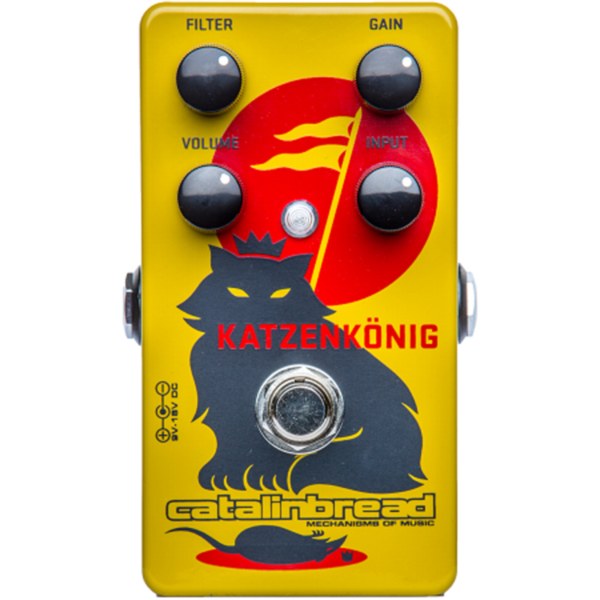
It’s no secret that most modern fuzz and distortion pedals are based on designs from the 1960s and ’70s. But revisiting old circuits doesn’t rule out creativity. Consider Catalinbread’s Katzenkönig, which weds a great ’60s circuit to an equally classic ’70s one while adding meaningful refinements—spawning a talented new offspring that often outshines its parents.
Art School Confidential I seldom dwell on stompbox cosmetics, but damn, this pedal looks cool. The image of the Katzenkönig (“Cat King” in German) presiding over his latest kill evokes early 20th-century Vienna Secession graphics. It’s gorgeous.
The circuit resides in a standard B-sized enclosure. You can power the pedal by battery or with any power supply voltage between 9V and 18V. The internal construction, with its modern, hand-populated circuit board, seems solid and damage-resistant.
Bender Basics To understand what Katzenkönig does and why it’s special, it helps to understand the circuits that inspired it. (Skip ahead if you know this stuff.)
The front half of the circuit is based on the Tone Bender MKII, widely considered the most desirable of the Tone Benders. (Not by me, for what it’s worth—the MKII is my least favorite of the four incarnations.) In the original, a germanium transistor makes the signal loud. A second transistor makes it very loud. A third one makes it ridiculously loud.
It’s one of the hottest fuzzes ever, with a heavily distorted signal plus enough level to bludgeon almost any preamp tube into overdriven submission. Lowering the two knobs on an original MKII (gain and volume) tends to neuter the impact, and there are no tone controls.
Bending the Rat Katzenkönig employs silicon transistors, which can mean an even louder, nastier Bender. Not here though—after the third transistor, the signal encounters the second half of a Rat circuit. On that pedal, an op amp generates gain, after which the signal encounters a pair of clipping diodes and a clever single-knob tone circuit.
On Katzenkönig, the diodes focus the blaring, splattery MKII sound. Lows get tighter and heavier. The filter control works wonders, enabling shades you’d never obtain from a MKII. Bright settings sizzle, but not excessively so, while dark tones maintain impact.
Another useful addition is an input trim control. On a Bender, it’s generally more effective to reduce gain by turning down your guitar volume than by adjusting the pedal’s gain knob. Here, the input pot does the job. (You can still use your guitar’s volume knob, but this arrangement is great for players who prefer to keep their guitar volume maxed out.) The control is perfectly scaled to compensate for output variations between pickups types.
Ratings
Pros: Unique distortion/fuzz hybrid. Ferocious yet focused distortion. Highly versatile.
Cons: Noisy.
Got Gain? Even cooler is the reimagined gain control. Vintage Benders crap out when you lower the gain, but Katzenkönig’s gain control provides killer tones throughout its range. (Geek detail: Instead of altering the voltage from a transistor to ground, it tweaks the resistance of a negative feedback loop between two transistors. I can report this with confidence because the pedal’s extraordinarily useful and detailed user’s manual includes a circuit schematic.)
I listened to Katzenkönig alongside accurate homemade MKII and Rat clones. Compared to a MKII, Katzenkönig is tighter, heavier, and more modern-sounding. You don’t quite get the low-end tightness of a Rat, and, for better or worse, there’s less of an ’80s metal feel. Meanwhile, the added and redesigned controls make the pedal vastly more versatile than either of its inspirations. But as on both MKIIs and Rats, high-gain settings can be noisy—you may need to ride your guitar’s volume knob or apply a noise gate to keep the buzzing in check.
Paired with a pre-CBS Strat, Katzenkönig fattened tones and smoothed highs—imagine a tighter-sounding Fuzz Face with a snappier attack. When I switched to a Gibson Trini Lopez with humbuckers, the sound was heavy but tight, with nicely balanced lows. Both pickup types delivered a focused fatness that lent complex harmonies and low-register harmonic intervals a clarity you’d never obtain from a MKII.
Someone clearly took the time to refine the ranges and tapers of all knobs. Katzenkönig provides genuinely useful sounds at nearly every setting—something you certainly can’t say about Benders or Rats.
The Verdict This spawn of a Tone Bender MKII and an early Rat doesn’t sound like either of its forebears. Instead, it splits the difference between the two. You get fiery fuzz with uncommon tightness—or, to put it another way, tough distortion with a strong dose of explosive fuzz. The pedal’s new and redesigned controls greatly extend its range, making it suitable for metal, punk, indie, or any style that benefits from aggressive yet disciplined guitar tones. Katzenkönig is well made. It looks great. The price is more than fair. It has tones of its own. This one’s a winner—all hail the Cat King!
